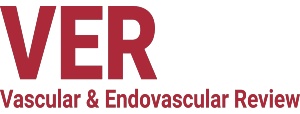|
Published online: Citation: Vascular & Endovascular Review 2019;2(1):5. Open Access:
This work is open access under the CC-BY-NC 4.0 License which allows users to copy, redistribute and make derivative works for non-commercial purposes, provided the original work is cited correctly. |
It is with great pleasure that we introduce to you, our readers, to the first issue of Vascular & Endovascular Review for 2019. VER was launched last year, with the aim of providing vascular interventionists with a resource to keep their practice up to date and to continuously develop their knowledge and effectiveness in day-to-day clinical practice through education and informative material. This issue features a range of articles on major areas of peripheral artery disease, aortic and carotid, as well as case reports, from renowned experts.
In our peripheral artery disease section, Spiliopoulos et al. discuss the currently available data and the future perspectives on below-the-ankle and pedal arch endovascular treatment, and Korosoglou et al. discuss the current evidence and future perspectives of the role of atherectomy in peripheral artery disease. In their article, Guevara-Noriega et al. provide a historical overview of vascular allograft transplantation through a literature review on its evolution and its use and acceptance by vascular surgeons, exposing three stages: preliminary experimentation; a decline in use due to long-term complications; and its current use in special indications subject to a thorough analysis. The last article in this section by Taneva et al. looks at the pELVIS Registry for the treatment of aneurysms involving the iliac bifurcation. They discuss the feasibility of the technique with good short- and mid-term results, and state that the most common anatomical challenge for iliac branch device use is the presence of aneurysmal deterioration of the internal iliac arteries, concluding that the relatively low procedure-related complications and repeat interventions show broad applicability of the technique.
In the aortic section, Coughlan et al. discuss transcatheter aortic valve implantation, and provide an overview of options for alternative vascular access in TAVI, the clinical rationale for using them, current evidence and areas for clinical investigation. Ramdon and Darling III look at acute type B dissections and discuss that, even though early treatment for uncomplicated type B dissections still remains controversial, certain characteristics may benefit from early intervention. In their study, La Barbera et al. discuss endovascular aneurysm repair (EVAR) using anaconda repositionable aortic stent graft assisted exclusively by intravascular ultrasound imaging, and conclude that a full EVAR procedure is feasible using only intravascular ultrasound navigation and repositionable aortic stent graft without contrast medium injection in anatomically selected cases. Xu and Li discuss the superior mesenteric artery (SMA) in fenestrated endovascular repair of complex abdominal aortic aneurysms and review current literature to improve understanding of the nature course of the SMA in fenestrated technology.
In the carotid section, Woo and Dearing outline the current guidelines for carotid artery stenosis and review current studies and analyses. Future studies and emerging technologies are outlined in an attempt to provide an evaluation of the current data and management of this complex problem.
Finally, we present three case reports. Mowafy et al. present a case of Mönckeberg’s arteriosclerosis in a young man with bilateral lower limb disabling claudication; Taneva et al. look at the combined less-invasive surgical and endovascular technique to minimise operative trauma and to treat excessive aortoiliac thrombotic obliteration with popliteo-crural involvement and acute limb ischaemia in a 51-year-old man; and Taneva et al. discuss the importance of follow-up imaging in the detection of delayed type 2 endoleaks despite complete aneurysmal sac shrinkage in two cases.
We hope you enjoy the reading this latest issue of Vascular & Endovascular Review.
